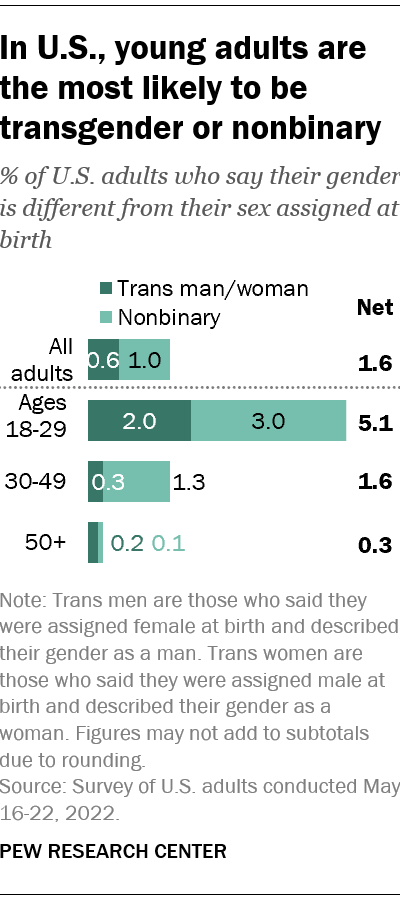Pronouns are becoming more important in the workplace as organizations ramp up their diversity and inclusion efforts. This Guide breaks down the importance of pronouns and the steps that organizations can take to ensure employees feel respected and appreciated in the workplace.
As gender pronoun awareness becomes more commonplace across all areas of life, pronouns are increasingly appearing in the workplace: in email signatures, on business cards, within LinkedIn profiles, and around the meeting table.
According to a 2022 report by Pew Research Center, 1.6% of the population, or 5.2 million people, identify as transgender or nonbinary.
That percentage increases in the under-30 age group, where 5.1% identify as transgender or nonbinary:
With Diversity and Inclusion in the workplace top of mind for many organizations, it’s important to understand gender pronouns and how to use them correctly when speaking to or about colleagues.
To that end, there are important steps organizations can start taking now to ensure they are fostering an inclusive workplace for all employees.
Understanding Pronouns and Their Importance
Understanding and respecting the basic need of humans to be understood, valued and respected for who they are is the first step employers can take towards building inclusivity.
Pronouns are one of the cornerstones of the English language and play an essential role in how we as individuals self-identify.
They are those words that are used to refer to ourselves by others when our proper name is not being used. They have traditionally included “he, him, his,” and “she, her, hers.”
English, unlike other languages, lacks a gender-neutral pronoun. Many queer, transgender, genderfluid, nonbinary and non-conforming individuals are uncomfortable identifying as the traditional he/him or she/her and are opting instead to use “they, them, theirs” or another non-binary pronoun option.
Gathering Unbiased Employee Feedback
A critical next step towards building inclusivity in the workplace involves gathering employee feedback.
Anonymous employee surveys allow employers to tap into the pulse of the organizational culture and design clear paths toward improvement. Moreover, these surveys do not need to be lengthy or complicated to be successful and insightful.
A short and simple survey around what employees understand about gender identities and pronoun use can pave the way for purposeful D&I training and impactful workplace pronoun policies.
Developing and Sharing Clear Pronoun Policies and Practices
More and more employers are incorporating pronoun policies into their workplaces, and for good reason.
A clear and well-written policy can highlight your organization’s commitment to diversity and inclusion, and establish clear standards for fostering a safe and supportive work environment for all employees.
Within these policies, you can help normalize pronoun-sharing by encouraging employees to share their pronouns if and when they are comfortable doing so. This could be within email signatures, on social profiles, in meetings, or wherever best fits your company culture.
It is necessary, in doing so, to understand that not everyone will be comfortable sharing their pronouns.
More importantly, employees should never be forced, or feel pressured, into sharing their pronouns with others, regardless of how they identify.
Keeping Pronoun Use Gender Neutral and Inclusive
It should go without saying that gender cannot be determined by appearance alone.
There are many ways that an individual may identify, including but not limited to cisgender, transgender, agender, bigender, non-binary, gender non-conforming, and genderqueer. Because of this, it is important to use gender-neutral pronouns when and where possible.
Unless you know how someone identifies, using pronouns like “they” in place of “he or she,” and “everyone” in place of “ladies or gentlemen,” can help avoid unnecessary and hurtful misgendering in the workplace.
Employers should also incorporate neutral pronouns into workplace policies and procedures, such as “the employee,” “chairperson,” and “foreman.” Additionally, employers should avoid using phrases such as “preferred pronoun,” as such phrases suggest that individuals choose their gender, which is not the case.
Avoiding Misgendering in the Workplace
Despite your organization’s best efforts, there will still be mistakes in the workplace.
If you or someone else accidentally misgenders a colleague, simply accept responsibility, correct yourself, and move on.
However, if someone is deliberately misgendering someone else in the workplace, there could be potential legal complications, as reflected in the EEOC’s 2021 guidelines.
Repeated and intentional misuse of someone’s pronouns could potentially form the basis for a discrimination claim, so it is important to take such claims seriously.
Adapting to Pronoun Use in the Workplace
Using pronouns in the workplace is a change that many workplaces are trying to gracefully navigate.
At the end of the day, it is important to remember that all individuals just want to be heard, understood, and respected for who they are.
Understanding and correctly using pronouns helps everyone feel respected and appreciated in the workplace, which ultimately helps make organizations more inclusive and effective.
XpanseHR Can Help
Whether it is helping build a stronger culture through engagement surveys, reviewing and providing employee handbook updates, addressing workplace conflicts fairly and efficiently, or helping keep your policies ahead of the latest changes and best practices, XpanseHR is here to help you build an inclusive workplace for your employees.
To learn more, contact us today:




